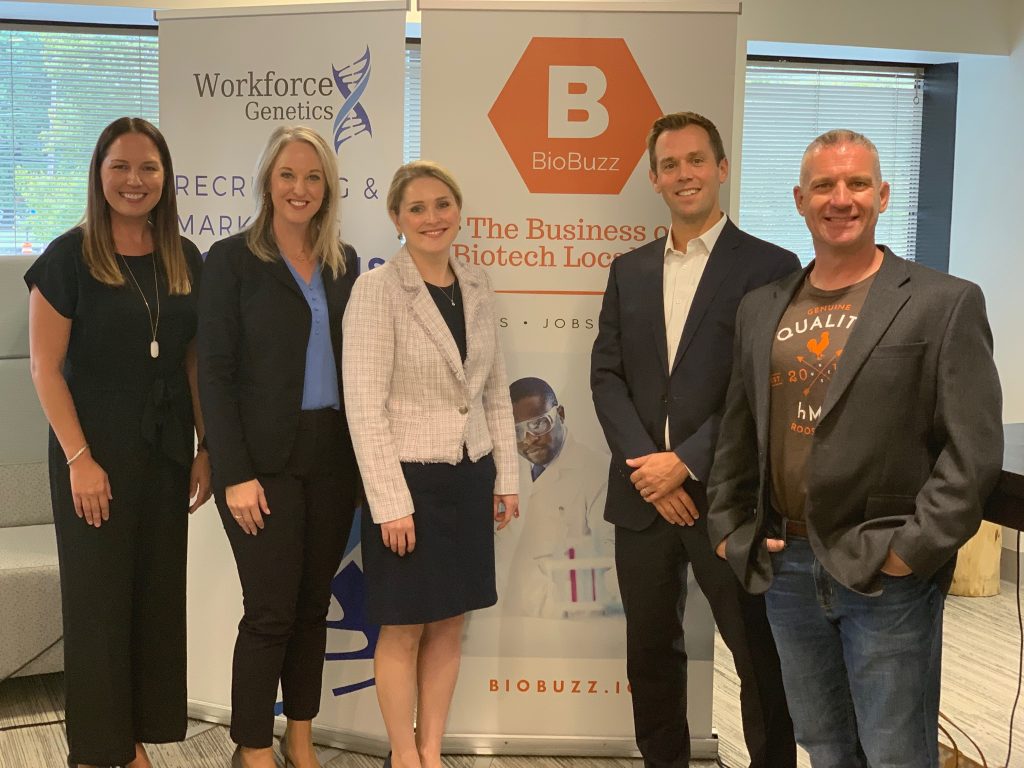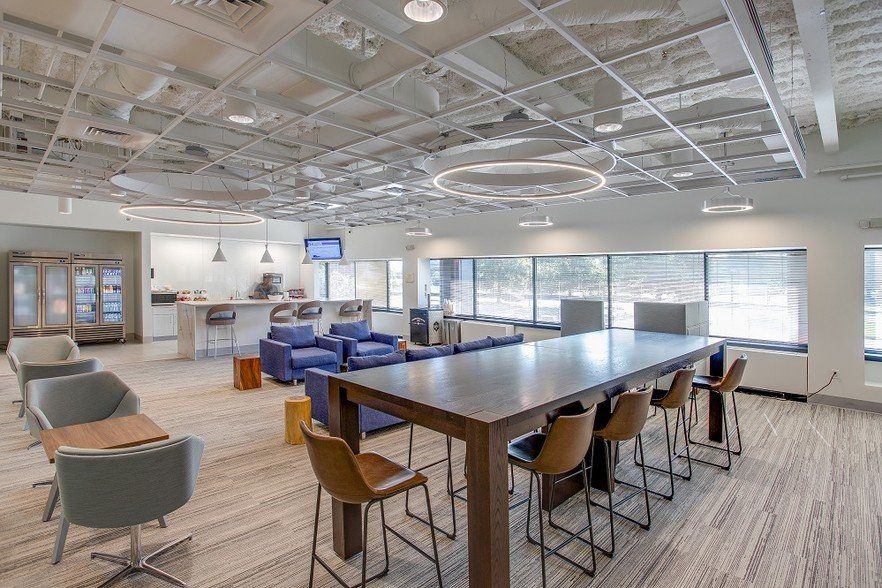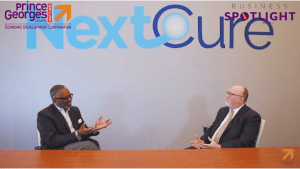
Maryland BioHealth Leaders Come Together to Share Solutions for Attracting & Retaining Top Talent
October 1, 2019
Attracting talent is one of the most commonly cited challenges voiced by company executives in the Biohealth Capital Region (BHCR). Rapid growth, particularly in the cell and gene therapy industry and advanced biomanufacturing, is applying strong pressure on companies that are up against a finite market with a skills gap, talent shortages and other regional recruiting challenges.
The inaugural ‘Talent Buzz’ panel, hosted by Workforce Genetics (WGX) and Scheer Partners, kicked off a new event series created to directly address regional talent attraction and retention challenges.
Talent Buzz events, like the recent panel held at the 704 Quince Orchard Road building, will continue to spotlight these challenges, help build a stronger community among those in the talent and recruiting fields and collectively elevate new ideas to grow the region’s talent pool.
The first event featured an expert panel including Matt Brady, Vice President, Scheer Partners; Ashley Nash, Director of Recruiting and Talent, Workforce Genetics; Ed Radwinsky, Head of People Operations, RoosterBio and Yulia Sayegh, Senior HR Manager, Senseonics Holdings Inc.
Whitney Harmel, Director of Strategic Partnerships at the Maryland Chamber of Commerce moderated the panel entitled “How Top Companies Attract, Engage and Retain Their Biohealth Workforce.”

The interactive panel covered a wide range of talent-related topics in-depth and included audience Q&A. Here is what the HR & Business leaders had to share about what their companies do to recruit and keep the best talent.
Creating and Managing Culture
Just five years ago, according to a 2011 survey conducted by the Korn Ferry Institute, benefits packages were the number one reason a candidate picked one job over another.
Today, company culture is the number one influence on a candidate’s employer choice, according to Korn Ferry’s most recent FutureStep survey.
Talent chooses to work with organizations that have strong cultures and employer brands. How well a company’s culture and employer brand is articulated during the search and recruiting process can make a huge difference to an organization’s ability to attract and retain the best talent available.
Culture building and management are big challenges for any company, but growth-stage companies like Frederick’s RoosterBio face an added challenge, according to RoosterBio’s Ed Radwinsky.
“We have 53 employess now, we had 40 when I started, and we’re looking to double over the next year, and the concern from every leadership member was ‘How do we maintain our culture as we scale?’,” stated Radwinsky.
To address this concern, Radwinsky met with every employee one-on-one (which he admitted was only possible due to the smaller size of the company when he came on board) and conducted weekly online staff surveys to keep his finger on the pulse of RoosterBio’s culture and how it might be evolving.
When a company is ten or fifteen core people, managing culture is relatively easy; at 50+ employees or more, culture management can be an immense challenge.
“When you’re small and you’re rapidly growing, you’re hiring people and you tend to get to the culture conversation later on. I think this is a faulty assumption to think of values as common sense… You have to make sure you are on the same page as your employees-you have to tell them what’s acceptable, what will take them to the next level, how we treat our business partners and colleagues and how executives talk to the entry level professionals…I think it’s important, especially when you are small, to start with values and what will help keep employees engaged and happy,” stated Senseonics Holdings Inc.’s Yulia Sayegh, who helped manage the company’s growth from 40 to over 200 employees in a very short time frame.
“Think about what’s going on every day. Are these things reinforcing your values or not? You have to make sure you have the right culture from the very beginning,” she added.
“Many early stage companies are still defining their values. Once established, companies have to be willing to hire and fire on these values. I think it’s really important that culture is not a one time thing. It’s about reinforcing these values every day,” stated Ashley Nash of Workforce Genetics.
“Culture can’t be something that’s just a poster on the wall,” stated Radwinsky, reinforcing Sayegh and Hamel’s sentiment that culture must come first and constantly be monitored, reinforced and maintained to keep a company healthy and growing.
Facilities, Collaboration and Culture
The location and design of office spaces shape the cultural and collaborative fabric of your company. Facilities are not just about bricks and mortar and lab equipment; they are a direct reflection on your company’s values and can serve to attract or repel talent.
“What we find is that the element of culture is pretty far down on the list and it shouldn’t be. It should be front and center. The way we look at things is can we achieve your functional elements and can we achieve your cultural elements?” stated Matt Brady of Scheer Partners. “Rarely does HR play a role. We work with CEOs and CFOs and facility-type people that are numbers-driven, not culture driven.”
“To bring in HR is important. You need top talent to get your products to market. We frame things in two ways when it comes to facilities: Location says a lot about your culture. And the layout of the space…plays a huge role in culture building,” he added. “Payroll is two to five times what facilities cost. HR needs more of a voice in these decisions,” he added.
Brady has been in the commercial office space industry for over 16 years. He shared that when he first started, functionality was the primary focus of companies seeking office space. Today, developing workspaces to support cultural aesthetics and a company’s ability to recruit and retain the best talent in the industry is the norm.

The space at 704 Quince Orchard, for example, was redesigned with smaller, growing companies in mind. These early stage companies can’t compete one-on-one with larger, more established companies with vast resources. However, when approached collectively, spaces like 704 Quince Orchard give startups and smaller bioscience companies the collaborative workspace they need to grow.
“We’re not all extroverts or introverts. Companies need to have space that accommodates every kind of working style. You can’t have one way or the other–it has to be a blend. Companies need to be very thoughtful and mindful about how they build their office space,” stated Nash. “You have to do what’s best for your people.”
This evolution from functionality to culture building and talent attraction reflects the growing influence of culture and employee branding on all aspects of a company’s operations.
Competing with Bigger Companies with Better Employer Branding
Startups and growth-stage companies don’t hire in a vacuum. These companies are competing for the best and brightest talent against big corporations with seemingly unlimited resources. Newer BHCR bioscience companies need to find new ways to differentiate themselves from bigger companies that can dangle bigger salaries, more comprehensive benefits packages, more attractive bonuses and a broader array of perks.
Startups and growing companies can’t compete from a resources standpoint with larger, more established organizations. They can compete by better showcasing their culture and employer branding. In essence, smaller companies need to do a better job of illustrating why their culture is a better fit for the best talent in the region.
“There’s no silver bullet. We are trying to bake in our value proposition and culture in everything we do…At RoosterBio, we’re trying to leverage our value proposition that focuses on cutting-edge technology and I’ve been working very closely with marketing to get this message out there. Early on most of our social media posts were very ‘sciencey’ with graphs and charts,” stated Radwinsky.
“Now, we are taking what gives us leverage over our competitors and telling this story online. We’re sharing what it means to be a ‘Rooster’ and how we operate, telling our employee’s stories about why they came, what they like and why they stay,” he added.
Nash commented on RoosterBio’s approach, stating, “It sounds like your employees are very engaged because they were able to impact your culture. They defined the values. It wasn’t the CEO saying ‘These are values and you must live by them.’ You asked them.”
“Culture is not just about foosball tables. It’s about connecting to the mission,” she added.
It’s important to remember, however, to differentiate between one’s employee value proposition and its culture. These two things are related but are not the same. The employer value proposition very often acts as the foundation for the culture that’s built around it.
“For Sensionics, the value proposition is making a difference and being impactful in the lives of patients with diabetes. We tell our job candidates that you can make a difference,” stated Sayegh. “This is the major anchor for our culture…the cause is important.”
What Other Talent Markets Can Teach the BHCR
According to Brady, one of the challenges faced by the BHCR is that it is a suburban market that does not have a Cambridge address. The perception is that Cambridge is a specific location where talented people can find multiple jobs quickly without relocating. There is a challenge communicating a sense of place when it comes to the BHCR and therefore communicating the benefits of living in the region is difficult.
“We highlight a variety of things when speaking to candidates. The first is that we are a growing epicenter and there is so much here…I also highlight the variety of options. You can have the suburban life or the city life and there’s a variety of cost options,” shared Nash. “You won’t find that in Cambridge and other tech hubs. If you’re trying to relocate people here, try to make the relocation easy. Offer a relo concierge and other services to make the move easy.”
“You need to paint a full picture for a candidate so they understand the benefits of living and working here as compared to other markets,” she added.
In many ways, a company’s value proposition, culture and employer brand need to tell the company’s story as well as what makes the BHCR different and better than other hubs.
“This is where your employer value proposition comes in. What can a candidate get from working with you? Can you provide opportunities they can’t get a bigger companies yet like new knowledge or management experience,” stated Nash.
“Another option is to look at less experienced candidates that have the right attitude and eagerness. So you can get them below market but with the opportunity to grow,” added Sayegh. “You can go after the professionals with some experience and maybe recruit retired people where money isn’t the main driver and you can give them equity.”
Crafting candidate personas, building a company’s value proposition, culture and employer brand while formalizing the interview process can make a big difference for smaller and growth-stage organizations trying to attract the right people in a highly competitive talent market.
Final Thoughts from the Panel
“I am very passionate about employer branding and understanding what makes your company special. And make sure you share that. Teach your employees to be brand ambassadors. Have employees share their stories. It’s a really great way to make your company stand out and provide candidates knowledge about your company,” stated Nash.
Radwinsky added, “Find out what’s most important to you and your company and reinforce that on social media and in your job descriptions and other processes you have in place.”
“Be students of facilities as you’re checking out the competition. See what’s working for other people. It is really important for HR to be involved. Your office is an important recruiting tool. Also, focus on the Maryland life science market. Promote that there is a real hub and vibrant community here. Your candidates will want to know that there are other options nearby if things don’t work out,” stated Brady.
“I am a believer that employees are the biggest asset for any organization. The talent that you hire and how you motivate them is everything. As HR professionals we need to remind the leadership and stakeholders that HR should be part of any decision-making that impacts employees. We are now changing the mindset of HR professionals to become more strategic. I urge you to speak up, to ask to be invited into facilities or IT meetings,” stated Sayegh.
“The CEO and COO are really numbers people. Employees are the biggest, most expensive asset. We need to make sure we always have the employer brand and people in mind,” she added, wrapping up the first event in the ongoing #Talentbuzz series on an aspirational and inspirational note.
- About the Author
- Latest Posts
Steve brings nearly twenty years of experience in marketing and content creation to the WorkForce Genetics team. He loves writing engaging content and working with partners, companies, and individuals to share their unique stories and showcase their work. Steve holds a BA in English from Providence College and an MA in American Literature from Montclair State University. He lives in Frederick, Maryland with his wife, two sons, and the family dog.






